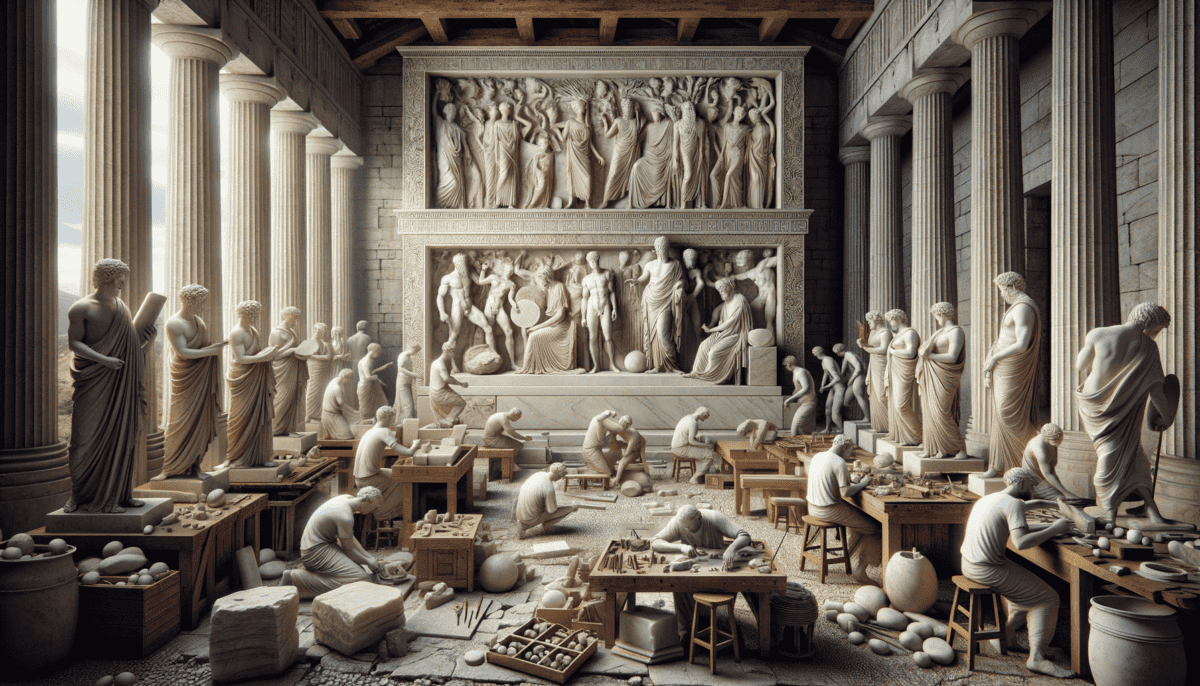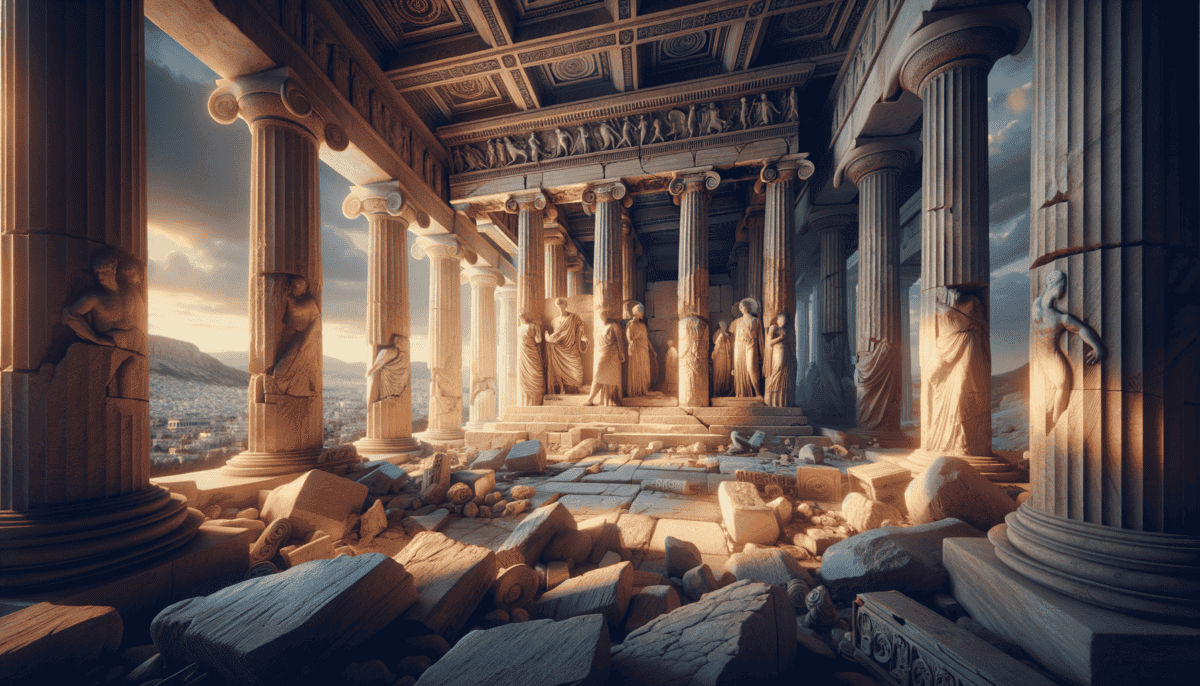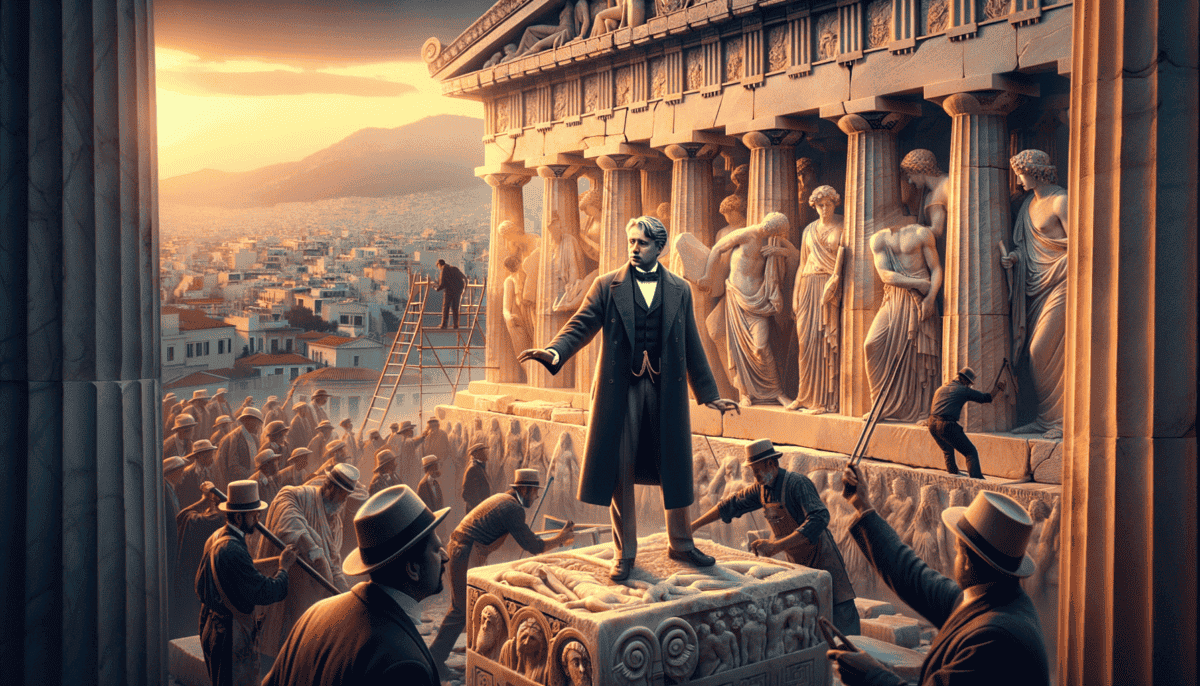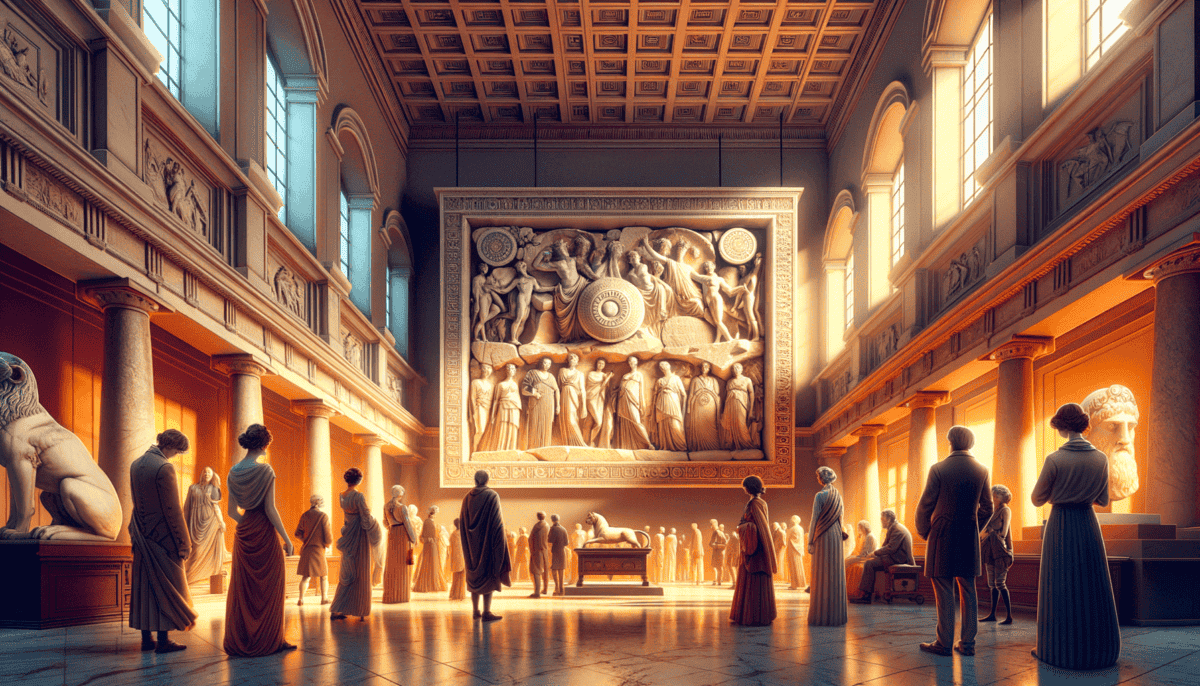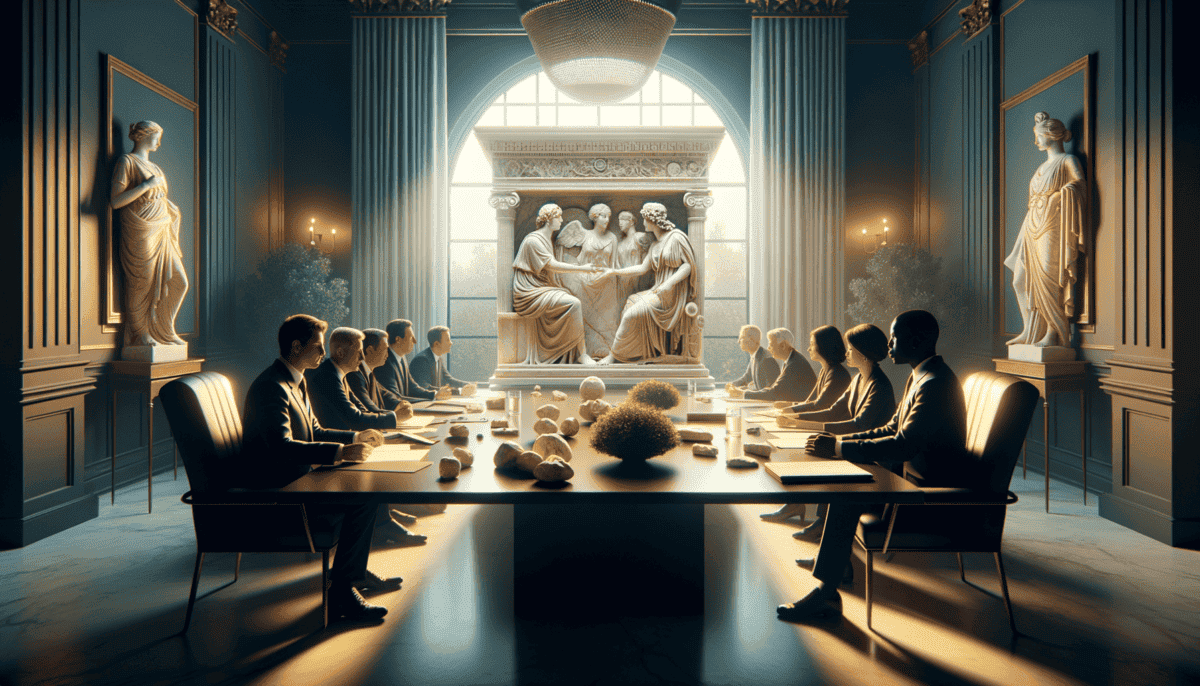The Golden Age of Athens
The warm Mediterranean sun shone brightly on the bustling streets of ancient Athens. It was the year 447 BCE, and something amazing was about to happen.
Little Maria skipped along the marble-paved road, holding her father's hand. She watched as workers carried huge blocks of white stone up the hill to the Acropolis.
"Papa, what are they building?" she asked, her eyes wide with wonder.
Her father, a skilled stone worker named Dimitrios, smiled proudly. "They're building a special temple for our goddess Athena. It will be the most beautiful building in all of Greece!"
A Special Place on the Hill
The Acropolis stood tall above Athens like a giant natural stage. At its highest point, hundreds of workers were busy creating what would become the Parthenon. The sound of chisels hitting marble filled the air with a musical ping-ping-ping.
“The Parthenon will be our gift to Athena,” Dimitrios explained. “She protects our city and gives us wisdom. This temple will show how much we love and respect her.”
The Master Artist
A tall man with a flowing beard walked past them, carrying drawings on pieces of parchment. Maria tugged at her father's tunic.
"Who's that, Papa?"
"That's Phidias, the greatest artist in Athens. He's in charge of building the Parthenon."
Phidias was special because he could see pictures in his mind before creating them in stone. He designed everything about the temple, from its tall columns to its beautiful sculptures.
Making Magic with Marble
Maria watched as white marble blocks arrived from Mount Pentelicus. The stone seemed to glow in the sunlight. Workers used special tools to:
• Cut and shape the marble
• Carve beautiful pictures
• Create tall columns
• Make statues of gods and heroes
A City’s Pride
As weeks turned into months, Maria visited the Acropolis often with her father. She watched the Parthenon grow taller and more beautiful each day.
"Will it take long to finish?" she asked one evening.
Dimitrios nodded. "Many years, little one. But when it's done, it will be the most wonderful temple ever built. People will come from far away to see it."
Fun Fact: The Parthenon took 15 years to build! That's longer than two lifetimes of a pet dog.
Stories in Stone
The marble walls began telling stories through pictures called friezes. They showed:
Heroes fighting monsters
Gods having parties on Mount Olympus
People celebrating festivals
Horses and riders in grand parades
Maria loved learning about these stories from her father. Each carved picture was like a page from a giant stone book.
A Dream Come True
As the sun set behind the Acropolis, casting long shadows across Athens, Maria looked up at the growing temple with pride.
"When I grow up," she declared, "I want to help make beautiful things like this too!"
Dimitrios squeezed her hand. "You will, my dear. The Parthenon shows us that when people work together and dream big, we can create something truly magical."
The temple wasn't just a building – it was Athens' way of showing the world how special their city was. And little Maria, like many children her age, grew up watching this magnificent structure reach toward the sky, telling stories that would last for thousands of years.
The workers continued their labor as the stars began to appear above the Acropolis. Tomorrow would bring another day of creating something extraordinary, one piece of marble at a time.
A Time of Masters and Marble
The morning sun cast long shadows across the workshop as Alexandros wiped sweat from his brow. He was one of the many skilled craftsmen working on the Parthenon’s beautiful marble sculptures.
“Be gentle with the chisel,” his master Lysander reminded him. “The marble will tell you where it wants to be cut.”
The Secret Language of Stone
Every day, the workers followed special steps to make the marble come alive:
• First, they drew their design on the stone
• Then, they used big chisels to remove large pieces
• Next came smaller tools for details
• Finally, they polished everything until it shone
“Each tap of the hammer is like speaking to the stone,” Lysander said with a smile. “We must listen carefully to what it tells us.”
A Daily Dance with Art
Young apprentices carried water and tools while master craftsmen worked their magic. The air filled with the sound of tapping chisels and scratching files. White marble dust sparkled in the sunlight like tiny stars. ✨
Important Note: The workers used over 100,000 tons of marble to build the Parthenon. That’s as heavy as 20,000 elephants!
Stories Come to Life
Alexandros loved watching the marble transform. Under skilled hands, flat stone became:
Flowing robes that looked soft enough to touch
Horses that seemed ready to gallop away
Warriors frozen in mighty battles
Gods and goddesses with kind faces
Special Tools of the Trade
Each worker had their own special set of tools:
The point chisel for rough work
The claw chisel for shaping
The flat chisel for smooth surfaces
Fine rasps for detailed work
A Community of Artists
“Look there!” said little Thais, Alexandros’s daughter, pointing at a newly finished horse. “It looks like it could run away!”
Alexandros grinned. “That’s because we work together, sharing our skills. Some are good at faces, others at animals. Together, we make magic.”
Secrets of the Masters
The craftsmen had clever tricks to make their work perfect:
“We use water to keep the marble from getting too hot,” Lysander explained to his students. “And we work early in the morning when the light is best for seeing details.”
A Living Legacy
As the sun set, Alexandros looked at his day’s work – a warrior’s shield that now showed every detail of its design.
“Papa,” Thais asked, “will people remember who made these beautiful things?”
“The makers may be forgotten,” he replied, touching the smooth marble, “but their work will speak for them. These stones will tell our stories long after we’re gone.”
The workshop grew quiet as the evening approached. But tomorrow would bring another day of turning simple stone into art that would amaze people for thousands of years to come.
Somewhere in the city below, families gathered for dinner, proud that their loved ones were part of creating something so special. The Parthenon was more than a building – it was the work of many hands and hearts, all working together to make something beautiful.
Through Time and Change
The great marble temple stood proud on the Acropolis hill. Sun and rain, winter and summer passed over it year after year. As time went by, the world around the Parthenon changed, but the beautiful building remained. ️
A Temple’s New Life
“Papa, why does the temple look different now?” asked young Marcus. The year was 432 AD, and he stood with his father looking up at the Parthenon.
“Well, son,” his father replied, “this temple has seen many changes. It started as a home for Athena, but now it’s a Christian church.”
The marble walls that once held Greek gods now echoed with new prayers. But the beautiful sculptures still told their ancient stories.
Many People, Many Uses
As centuries passed, different people used the Parthenon in new ways:
The Greeks built it as a temple
The Romans came and added their own art
Christians turned it into a church
Later, it became a mosque with a tall tower
Nature’s Challenge
The marble stayed strong, but it wasn’t easy. Rain and wind tried to wear it down. The hot sun made tiny cracks bigger. But still, the Parthenon stood tall.
“Look how the marble still shines!” said Sofia, a local girl, to her friend. “Even after all these years, it’s still so pretty!” ✨
Keeping the Stories Safe
People tried their best to protect the ancient building. They fixed broken parts and cleaned the marble. But some problems were too big to solve:
• Rain water seeped into cracks
• Plant roots grew between stones
• Dirt and smoke made the white marble dark
• Wars brought danger to the beautiful sculptures
A Close Call
“What happened here?” asked Ahmed, looking at some broken columns in 1687.
“A terrible accident,” his grandmother said sadly. “During a war, gunpowder stored in the temple exploded. Many beautiful parts were damaged.”
Hidden Treasures
Even with all these problems, the Parthenon kept many of its secrets safe. Behind fallen stones and under years of dirt, the fine details of the sculptures waited to be found again.
“The old stories are still here,” whispered Maria, touching a carved horse’s head. “We just have to look carefully to find them.”
Standing Strong
By the 1800s, the Parthenon had lived through:
Thousands of rainstorms
Hundreds of earthquakes
Many wars and battles
Changes in religion and rulers
But like a mighty tree that bends in the wind but doesn’t break, the marble temple survived. Its white stones turned golden in the sunset, just as they had done for over two thousand years.
“Will it stay forever?” young Nikos asked his teacher, looking up at the ancient columns.
“That depends on us,” she answered. “If we take good care of it, the Parthenon can keep telling its stories for many more years to come.”
As the evening shadows grew long, the old temple stood silent but strong. Tomorrow would bring new challenges, but for now, the marble glowed with the same beauty that had amazed people for generations.
Lord Elgin’s Big Move
In 1799, a tall man with fancy clothes stepped off a ship in Athens. His name was Lord Elgin, and he was about to change the Parthenon’s story forever.
A Special Mission
“What brings you to Athens, my lord?” asked a local guide.
“I want to draw pictures of these old buildings,” Lord Elgin said. “The king of England sent me here.”
But Lord Elgin soon wanted more than just pictures. He saw how beautiful the marble sculptures were. He worried they might get broken or lost.
The Big Decision
Lord Elgin talked to the rulers of Athens at that time. They were called the Ottoman Empire.
“Please let me take some of these marbles to England,” he asked. “I will keep them safe in a museum.”
The rulers said yes, but many people weren’t happy about it.
Moving the Marbles
Moving huge pieces of marble was very hard work:
Workers had to build special tools ️
They used ropes and wooden frames
Some pieces were very heavy
They had to be careful not to break anything
“Watch out!” shouted a worker as they lowered a big piece. “These sculptures are over 2,000 years old!”
A Difficult Journey
Getting the marbles to England wasn’t easy. One ship even sank!
“Don’t worry,” Lord Elgin said. “We can get them back from the bottom of the sea.”
And they did! Divers went down and brought the marbles up.
Different Opinions
“Is it right to take these away from Athens?” asked Maria, watching the marbles being packed.
Some people said yes:
• The marbles would be safer in England
• More people could see them in a museum
• They might get broken if they stayed
Others said no:
“These belong to Greece!”
“They’re part of our history!”
“The Parthenon needs all its pieces!”
A New Home
Finally, the marbles arrived in England. Lord Elgin put them in a special room. People came from all over to see them.
“Look how beautiful they are!” visitors would say. “But why aren’t they in Greece?”
Questions Without Answers
The story of Lord Elgin and the marbles still makes people think hard questions:
“Who should take care of old art?”
“Where should ancient treasures live?”
“How do we share the world’s special things?”
As the sun set over London, the Parthenon marbles sat in their new glass cases. Far away in Athens, empty spaces on the old temple waited silently. A story that started in ancient Greece had taken an unexpected turn, and it wasn’t over yet.
A Tale of Two Cities
The big marble pieces finally reached London in 1812. They came on boats across the sea, wrapped up like giant presents.
Welcome to London
“Look at these amazing sculptures!” people in London said. They had never seen anything like them before.
The British Museum gave the marbles a special home. They put them in big rooms with lots of light. People from all over came to see them.
Back in Athens
“Our beautiful marbles are gone,” said Maria, an old Greek lady. “The Parthenon looks empty without them.”
Many Greek people felt sad. The marbles were like pieces of a puzzle, and now part of their puzzle was missing.
Two Different Views
People had different thoughts about where the marbles should be:
• Others said: “They belong in Greece with the Parthenon”
• Many asked: “Can’t we share them somehow?”
A New Museum in Athens
“We can take good care of our treasures too!” Greece said. They built a beautiful new museum right next to the Parthenon. ✨
The new museum had special spots waiting for the marbles to come home.
Talking About Sharing
“Can we work together?” asked Greek museum people.
“These marbles are important to everyone,” said British museum people.
Both sides started having big talks about what to do.
The World Watches
Other countries watched and wondered:
“How do we share things that belong to everyone?”
“What’s the right thing to do?”
Hope for the Future
Today, people still visit the marbles in both places. In London, they stand in quiet museum rooms. In Athens, pictures of them hang where they used to be.
“Maybe one day,” whispered a little girl in Athens, “all the pieces will come together again.”
The story of the Parthenon marbles became bigger than just stones and sculptures. It became a story about sharing, caring for old things, and working together.
New Ideas Growing
Smart people from both countries kept thinking of new ways to solve this puzzle. Some suggested:
Taking turns showing the marbles
Making perfect copies
Using special technology to share them
Finding ways for both museums to work together
As the sun set each day, it shone on the same marbles in two different places. The story wasn’t over – it was just waiting for its next chapter.
A Bridge Across Time
The sun rises over Athens and London at different times, but it shines on the same story.
New Ways Forward
“Look what we can do now!” says Dr. Sofia, holding up a special computer. “We can make perfect 3D pictures of the marbles!”
Scientists use fancy cameras and computers to scan every tiny part of the marbles. They can show them in ways people never could before! ✨
Working Together
“Maybe we can be friends and share,” says Tommy, a young student visiting the British Museum. “Just like we do at school!”
More and more people think like Tommy. They want to find ways to make everyone happy.
Special Traveling Shows
Museums start doing something new. They send pieces of art to visit other countries. It’s like the marbles could go on vacation!
A Greek museum helper smiles: “When art travels, people learn new things.”
Big Changes Coming
• People want to fix old problems
• Both sides listen more
• New ideas pop up every day
What Kids Think
“I learned about sharing from the marbles,” says Maria, a little girl in Athens. “Sometimes when you share, everybody wins!”
Children in both countries draw pictures of the marbles and write stories about them. They see things differently than grown-ups do.
The World Joins In
Other countries help too! They suggest:
– Using new technology to share art
– Finding fair ways to solve old problems
Dreams for Tomorrow
A museum guide in London speaks softly: “Every piece of old art tells us something important. When we work together, we learn more.”
The Parthenon marbles remind us that beautiful things can bring people together. They teach us about sharing, caring, and being kind.
The Story Goes On
The marbles still sit in two places, but they’re not alone anymore. They have new friends – people who care about them all around the world!
Some dream of seeing them all together again
Others think of new ways to share their story
Everyone learns from these ancient stones
As we look to the future, the Parthenon marbles keep teaching us. They show us how art can build bridges between people, even across oceans and time. Maybe that’s the most beautiful part of their story.
Just like the marbles have lasted for thousands of years, the hope for understanding and friendship between countries lives on. And that makes this story not just about old stones, but about all of us, working together to make tomorrow better.


